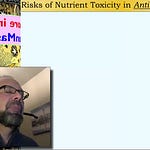Some basics about wine and whiskey, part 1—see video embedded above
In this post, I digress from antiviral nutrition, functional medicine clinical protocols, Human Microbiome and Dysbiosis, the critical importance of vitamin D, the utility of NAC, corruption of medicine (PDF) and hijacking of democracy by the technoglobalists, structured thinking vs collapse of the pillars of society, the inflation/shrinkflation/greedflation scam and a wide range of other topics listed in the INDEX OF TOPICS.
The unedited video originally posted Dec23 has been reviewed, slightly edited with better color, one small correction, and some closing tunes at the end—the updated video has now (Dec24) replaced the original.
1. The Law of Wine: (most important concept)
A "good wine" is a wine that you like and that you can afford, per John Cleese
2. Many different types of grapes with different flavors can be used to make wine, and these can be used alone or in various combinations to create the desired flavor;
My personal favorites are Primitivo/Zinfandel, Cabernet sauvignon, Tempranillo, Granache.
3. Different countries/soils/climates/years will impart different flavors to the grapes and the wine:
Spain's RIOJA region is famous for affordable and quality wines
France's BORDEAUX overuses pesticides such that a friend from France (from the Bordeaux region) told me that even the people won’t drink the wine from their own region
Chilean wines are considered “reserve” after how many months?!?!?!?
4. More age = generally better flavor, especially when aged in oak barrels
Nondescript, table wine
Crianza = 2 years, young but can be good
Reserve = 3 years (except in Chile = 6 months!)
Grand Reserve = 5 years
5. Know how to open a bottle of wine just using your hands
See the video so you won’t be a chump
6. You only need to know 2 things about whiskey
See the video so you won’t get a headache/hangover
Celebrating the BEAUTY (7) of creativity, humanity, nature, in Social Architecture; The nonspoken implications of Art Nouveau
In this post, I digress from antiviral nutrition, functional medicine clinical protocols, Human Microbiome and Dysbiosis, the critical importance of vitamin D, the utility of NAC, corruption of medicine (PDF) and hijacking of democracy by the technoglobalists
Health Homework (30.1) Complement your Bucket List with a Fuckit List
“The goal of a bucket list isn’t to do crazy stupid stuff in a futile retort to the inescapability of death but to fully manifest one’s desires and values while one is alive, especially those desires and values that one has postponed out of shame or obligation.”
COURSE INDEX Human Microbiome and Dysbiosis in Clinical Disease
The Present: Listing of Videos Currently Available (and Coming Soon) The video series outlined below extends from the book “Human Microbiome and Dysbiosis in Clinical Disease” (2015) which is included in the larger textbook Chapter 4 of Inflammation Mastery: Textbook of Clinical Nutrition and Functional Medicine
















Share this post